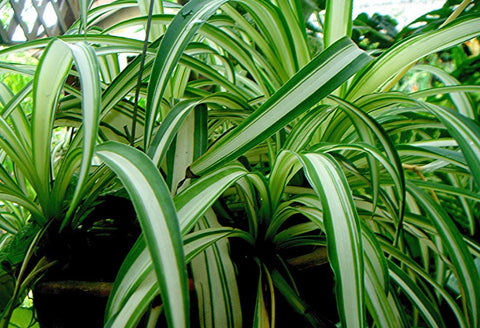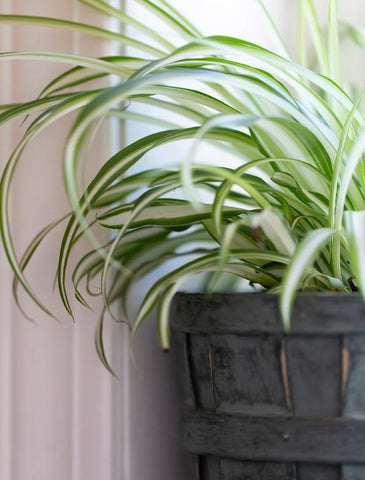Learn How to Care for a Spider Plant: Grow Lush, Healthy Plants Easily
Spider plants are popular houseplants among novice and seasoned plant lovers for their easy-care needs. These pet-friendly plants from South Africa thrive in moderate temperatures and humidity and grow well in medium indirect light.
With their distinctive arching leaves that can grow as long as 12 to 18 inches, spider plants can add a touch of greenery to any interior space.
In this comprehensive guide, we'll explore everything you need to know about how to care for a spider plant, ensuring it flourishes and remains vibrant all year round.
About Spider Plants

Spider plants, or Chlorophytum comosum, are elegant indoor plants from the Asparagaceae family. These plants originate from Central and Southern Africa but are now omnipresent in households worldwide, thanks to their fast-growing nature and ability to adapt to varying climatic conditions. This tropical beauty is also known as spider ivy or ribbon plant.
Chlorophytum comosum is a nearly hard-to-kill plant, which is renowned for its enduring charm. The plant can be distinguished by its long, arching fronds that cascade gracefully from the center, resembling the delicate legs of a spider.
The best thing about spider plants is their low-maintenance needs, making them a perfect choice for beginner gardening enthusiasts. While bright, indirect light and well-draining soil are highly recommended for these plants, they can tolerate lower light conditions and occasional neglect, too.
Spider Plant Benefits
There are many benefits of bringing home a spider plant, such as:
- In Feng Shui, spider plants are believed to bring positive energy, and promote a sense of harmony and balance.
- According to NASA, these plants function as natural air purifiers, absorbing toxins like carbon monoxide, xylene, formaldehyde, and toluene.
- Adding a spider plant to a patient's room speeds their recovery process.
- These ribbon-like plants increase indoor humidity, alleviating respiratory symptoms.
Spider Plant Care: How Do I Keep My Spider Plant Happy?

To keep your spider plant happy, you need to meet its growing requirements. From light, watering, soil, and fertilization to pruning and preventing common issues, our comprehensive spider plant indoor care guide will help you in this quest.
Spider Plant: Light Requirements and Watering Needs
A spider plant is sensitive to direct sunlight, which can scorch its delicate leaves. Hence, it's best if you place it near a window that receives bright, indirect light. Chlorophytum comosum can tolerate low-light conditions, too, so it won’t suffer during overcast spells.
To meet the spider plant’s watering needs, make sure that the soil doesn’t stay soggy. Overwatering your plant can only lead to leaf issues, root rot, and harm to its overall health. The best practice is to water your spider plant when the topsoil feels dry to the touch.
How Much Light Does a Spider Plant Need?
A spider plant does well if it gets at least 4 to 6 hours of bright, indirect light. This much light is sufficient to promote robust growth and maintain its overall well-being.
How Often to Water a Spider Plant?
Although there’s no fixed schedule to follow when it comes to watering a spider plant, about once a week is usually sufficient for this indoor plant. Also, your green companion will indicate when it’s thirsty. Just check the top two inches of the soil, and if it feels moist, refrain from hydrating your plant.
In addition, make sure to use only rain or distilled water. Tap water isn’t good for your spider plant, as it is sensitive to chlorine and fluoride.
Spider Plant: Soil & Fertilizer
Like other houseplants, the health of your spider plant also depends on the soil it lives in and the fertilizer you feed it.
What Kind of Soil Do Spider Plants Like?
Spider plants like loamy soil with good drainage. Although a neutral pH is the best, these plants won’t mind if their soil is slightly acidic or alkaline.
What Is the Best Fertilizer for Spider Plants?
If you’re looking for the best fertilizer to feed spider plants, nothing beats an all-purpose granular or water-soluble fertilizer. Refer to the product’s instructions for best results.
Don’t over-fertilize your spider plant, as it can negatively affect their health. Feed your plant a couple of times during the active season, in the spring and summer.
Repotting a Spider Plant

A key aspect of spider plant care is knowing when and how to repot this gorgeous houseplant to ensure its healthy growth and vitality. Transplanting it into a bigger pot gives the roots extra room to grow, preventing them from circling.
How to Repot a Spider Plant?
Here are the simple steps to repot a spider plant:
- Gently pull your spider plant out of its current pot.
- Loosen the roots to enable them to grow outwards in the new container.
- Take the new pot and fill it half way with a fresh repotting soil mix.
- Hold your plant at its base and lower it into its new pot; add more soil up to an inch below the brim of the container.
- Press gently to remove any air pockets in the soil and water the plant thoroughly.
When to Repot a Spider Plant?
Early summer or spring is the best time to repot a spider plant. But don’t overlook signs, such as root crowdedness, yellow leaves, stunted growth, and root rot. These should also prompt you to repot your spider plant, regardless of the time of the year.
Spider Plant Temperature and Humidity
60°F to 80°F is the ideal temperature range to keep a spider plant thriving. It’s crucial to keep this potted plant away from drafts and air-conditioning vents if growing it indoors. The spider ivy does well in moderate humidity. If your Chlorophytum comosum’s leaf tips are turning brown, it may be a sign of underwatering or the air being too dry. Misting your plant can help in this situation.
How to Prune a Spider Plant and When?

A spider plant is a fast-growing houseplant, and thus, it often goes out of shape, looking overgrown. If your plant appears to be turning into a wild, unruly mess, it’s time for some trimming!
To manage its growth, early summer or spring is the best time to prune your spider plant to speed up its recovery process. You should also trim damaged or unwanted foliage if you see signs, such as leggy appearance, yellow leaves, brown tips on the leaves, etc.
How Do I Make My Spider Plant Bushier?
You can make your spider plant bushier by pruning it regularly. To do so, firstly, prepare your sharp scissors or pruning shears by sterilizing them. When you’re ready to trim, cut the fronds at the base, at a 45° angle. This not only gives a clean cut but also helps the plant heal faster.
Make sure to remove any baby spider plants, called plantlets or spiderettes, as they take up the energy of the mother plant. Gently snip them near their base. These can be used for propagation to expand your spider plant collection or to make a thoughtful plant gift to a friend.
Once you’re done trimming your green buddy, don’t leave it hanging. Water it thoroughly and ensure it receives plenty of bright, indirect sunlight for optimal recovery.
How to Propagate a Spider Plant?
Propagating a spider plant is not rocket science, and you’re good to go if you know the basics. There are three ways to propagate a spider plant: by dividing the main plant, or rooting the spiderettes in soil or water.
To propagate a spider plant by division, start by gently removing the main plant from its pot. Carefully separate the roots and plant the individual sections of the spider plant in separate pots filled with well-draining soil. Water your newly potted plants lightly. Provide them with indirect sunlight to help the roots establish and grow.
Propagating a spider plant in soil involves either cutting carefully the spiderettes and planting them independently in smaller pots or doing the same but leaving the baby spider plants still attached to the stolon (runner). Once the roots become stronger, you can cut the stolon and separate the plantlet from the mother plant.
The spider plant water propagation method is also easy. Just cut gently the spiderettes and root them in a jar of water. Then move them to pots with well-draining soil.
Common Spider Plant Problems

Spider plants usually don’t experience many issues, but even if they do, it’s quite easy to fix them.
- Brown tips: Brown tips on the leaves of a spider plant typically indicate overfertilization, dry indoor air, or underwatering. Reduce the frequency of feeding your plant or use half-strength fertilizer. Also, ensure adequate moisture in the air, and water your plant when the soil feels dry. You can trim the brown tips on the foliage to improve your spider plant’s look.
- Yellow leaves: Yellow leaves are another common issue with a spider plant, mostly due to direct sunlight or overwatering. Shift your green buddy to another place with indirect light to fix the problem.
- Pests: If you see unwanted guests like mealybugs, spider mites, and scale insects on your plant, remove them immediately using an insecticidal soap or neem oil spray.
- Curly leaves: Lack of nutrients and inappropriate watering are often the main culprits behind curly leaves on a spider plant. Adjust the watering and feeding schedule accordingly to remedy the issue.
- Root rot: Excess water around the roots of your spider plant leads to rotting. The only solution to this problem is to ensure good soil drainage and avoid overwatering the plant. Trimming the damaged roots and repotting your plant in a new pot with fresh, well-draining soil will help, as well.
Spider Plant Care: FAQs
Q: Do spider plants like bottom watering?
A: Spider plants like bottom watering, but only when the soil is completely dry. If there’s still some moisture in the soil, it’s a good idea to avoid bottom watering. Note that watering houseplants over the soil helps flush any salt buildups.
Q: Why is my spider plant leggy?
A: Your spider can be leggy for several reasons, such as lack of sufficient light and nutrients in the soil. Also, failing to trim the baby spider plants can put a strain on the mother plant. So, prune it as soon as possible.
Q: Can spider plants live in low light?
A: Although spider plants prefer bright, indirect light, they can also tolerate low light conditions to some extent.
Q: Is the spider plant toxic to pets?
A: No, the spider plant isn’t toxic to pets. Still, if your curious cat or dog nibbles on the plant, they may suffer from some digestive issues.
Q: Do spider plants clean the air?
A: Yes, spider plants have air-cleaning properties, as the NWF’s research shows. They effectively absorb almost 95% of harmful toxins from the air, including carbon monoxide.
Conclusion
Spider plant care involves providing your green companion with adequate light, water, fertilizer, and the right temperature and humidity. Pruning and repotting your Chlorophytum comosum is also essential for its health and vibrant look. Remember to keep your plant’s soil moist but not waterlogged and to avoid direct sunlight exposure.
By following these simple guidelines, you can enjoy the beauty and benefits of these resilient houseplants for years to come. You can pair your spider plant with some gorgeous companion plants, such as the lovely golden pothos, a variety of snake plants, or a blooming peace lily to create a harmonious indoor environment.












Leave a comment